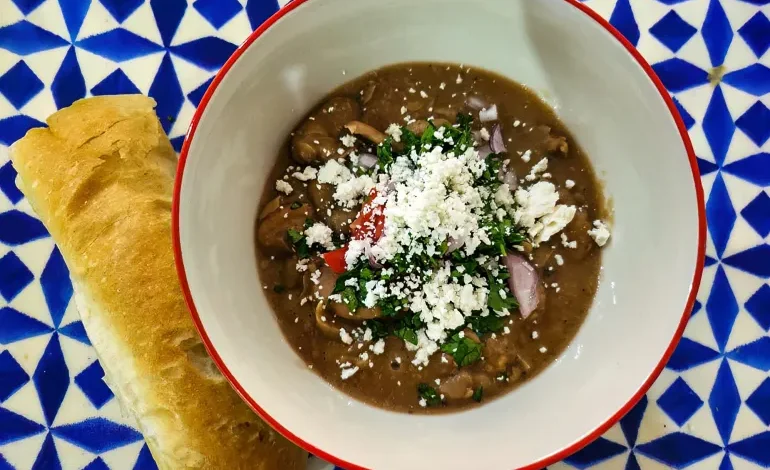Ramadan recipe: In Sudan, fuul completes the iftar table

In our household, we eat it every day – for the whole month.
The table is not complete unless that dish of fuul (fuul medames or stewed fava beans) is smack in the middle surrounded by the supporting cast of other dishes.
Fuul is very popular in the Arabic-speaking part of the world and during the fasting month, it is usually served at suhoor (the pre-dawn meal eaten before fasting starts).
However, that is not quite the case for many families in Sudan, who apply the literal meaning of “fatour” (iftar, or breaking the fast) and make the meal into breakfast, with most of the dishes more reflective of the first meal of the day – eggs, taameya (falafel), soup, salad and, of course, fuul.And I have to say that in our house, like in many others, it cannot be the tinned fuul. That has been akin to culinary blasphemy for generations as people insisted on making it the “proper way” with the beans soaked overnight and then slow-cooked until tender.
But I dare admit more people are starting to accept the charms of the tinned bean; it does make things easier and quicker, and it is what I have used in the recipe below.
Fuul and company
When it comes to fuul, there are certain memories that come to mind and they inevitably involve others being in the picture. That is one of the things about eating fuul – it is not done alone, it is always a group thing: be it family, friends, work colleagues or strangers gathered at a sidewalk eatery sharing a plate.
After sitting for our university entrance exams, my friends and I had a lot of free time on our hands but were still expected to go to school. So one day, we decided to skip class and go to the corner shop that was famous for its fuul.There we were, in our school uniforms, attacking this huge, deep, metal plate of freshly made fuul, complete with all the garnishes and add-ons, sitting on upturned plastic soda crates and chugging down cold fizzy drinks.We did not care about food hygiene, we just wanted to eat fuul and talk about our future. We were hungry but not smart, as we were caught by a teacher, who duly reported us to the principal, who, in turn, took great pleasure in dishing out detentions.
During an election day years later, I went on a “scouting” trip with fellow activists to see for ourselves if there really was as a huge voter turnout as the government kept telling us.
There we were, driving from one neighbourhood to another, looking for all the voters who were queueing in their thousands to cast their ballot for Sudan’s former President Omar al-Bashir. There were none.
Scouting mission done, hunger pangs kicked in and off we trotted to this greasy spoon in the industrial area of Khartoum. The fuul plate was different this time, as it had the added bonus of freshly made taameya crumbled on top, along with the mandatory white cheese, and tahini on the side.The bakery next door supplied the baladi bread (whole wheat pitas) and, with a plastic jug of the world’s best fresh grapefruit juice on hand, we dug in. Electoral observational work is hungry work, and it also supplied the laughs as we tried to guess what voter percentage the al-Bashir government would trot out.
For the love of fuul
Why fuul?
That dried broad bean can take on a lot – be it seasoning, condiments or add-ons – and it packs a punch. The nutritional benefits of the fava bean are myriad, providing, among other things, magnesium, vitamin B, iron and manganese, which helps prevent osteoporosis and digest glucose among a number of other health benefits.
It is a superfood and one that is easily available to people of all income levels.
At home, our flavour profile is salt, black pepper, a little shatta (chili powder), ground cumin – loads of it – and a lot of lime. Not lemons, they are too sweet, you need lime for that acid kick.
Then come the veggies: finely diced red onions and tomatoes which are not cooked with the fuul but added to the plate and gently mixed in – you do not want mushy vegetables.
Next comes the good part, the final piece of the jigsaw that brings this whole dish together: sesame oil. Sudan’s sesame seed production is among the highest grade in the world.
At one point, a few years ago, Sudan was the largest global producer and exporter of sesame seeds. As such, we take great pride in our oil and halva sweets. So while many may opt for olive or vegetable oil, no Sudanese household would dare serve a plate of fuul without sesame oil. And then to top it all off: crumbled white cheese (Sudanese feta) mixed with some finely chopped parsley. No parsley? Any green herb would work, failing that arugula is a great substitute, as well.
Fuul is not everyone’s preference. Many Sudanese are opting to serve mulaah, a broth-based stew made with dried okra and mixed with minced meat or dakwa (ground peanut paste). That is usually eaten with a savoury set pudding called “asida” that is made from sorghum flour or kisra, a wafer-thin crepe-like flat bread made from fermented sorghum, similar to the Ethiopian injera but less thick.










